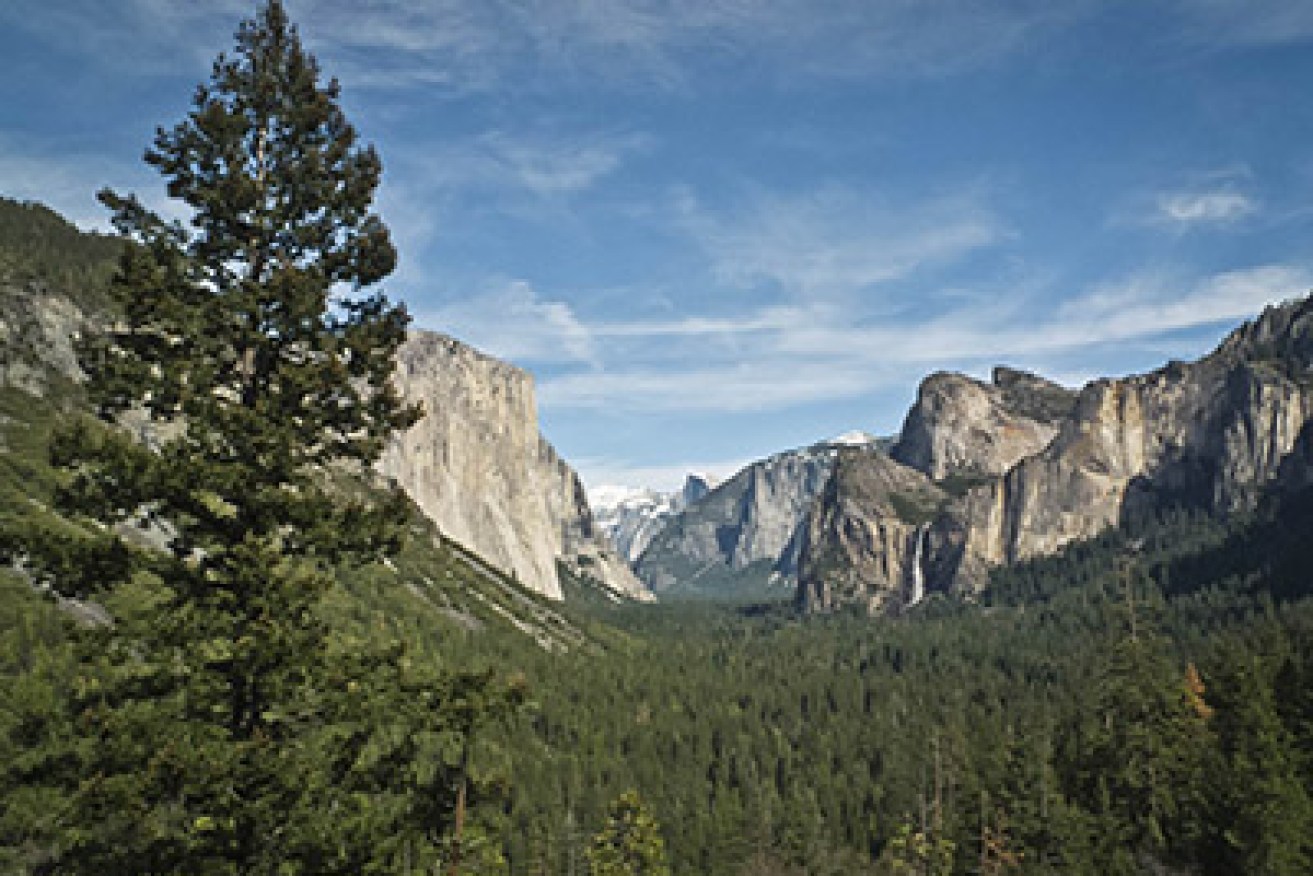Extreme sports: the real cost

Dean Potter’s death last weekend, in a wingsuit BASE jump in Yosemite National Park that went wrong, sent shock waves through the climbing community, where he was considered one of the most talented, visionary, and polarising figures.

It’s illegal to BASE jump in all US national parks, including Yosemite, and it was possible Dean Potter and Graeme Hunt jumped at dusk or at night to avoid being caught by park rangers. Photo: AAP
There are few people who have pushed the limits of what humans are capable of to the extent that Mr Potter did, and his exploits were legendary in the small but growing world of extreme sports.
The deaths of Potter and his friend Graham Hunt are particularly poignant tragedies in a sport that has claimed dozens of lives in recent years and is considered by many to be the most dangerous sport there is.
“In the adventure world, I’ve lost a lot of friends to climbing and BASE jumping,” Corey Rich, a photographer who had photographed Potter’s jumps and knew him for years, told the Associated Press.
“On one level, you lose a friend. But it’s also difficult to be surprised because BASE jumping is the most dangerous thing you can do. The odds are not in your favor, and sadly, Dean pulled the unlucky card.”
• Football hits ‘worse than facing Muhammad Ali’
• How to cut sugar from your diet the healthy way
• Stray dog follows adventure team for 40kms
Potter was a top athlete who always pushed limits and seemed to many to be invincible.
But extreme sports are growing in popularity and visibility, thanks in part to the rise of social media and the availability of portable GoPro cameras, which extreme athletes can affix to their helmets or other gear to document their thrills – one factor that has brought daredevil acts to a wider audience in living color.

Dean Potter (pictured) and his companion Graham Hunt, died after jumping from a 7,500 foot promontory at Yosemite National Park. Their parachutes had not been deployed. Photo: AAP
“Certainly many of these [extreme] experiences seem and are more accessible than they used to be – media coverage and internet communities have something to do with that,” Emma Barrett, co-author of Extreme: Why Some People Thrive at the Limits, says.
She says that while media may encourage some of the increase, the desire to try risky sports may also be reflective of a societal trend in which some people are turning away from material possessions toward “experiences” as a source of happiness.
And the social-media bragging rights could play a role too, she adds, explaining a theory that: “Engaging in activities and then bragging about it on Facebook is the 21st-century equivalent of ‘keeping up with the Joneses’.”
But Ms Barrett also notes that the forces that drive top extreme athletes, like Potter, to take the risks they do are often very different than people imagine – and the popular notion of people being “adrenaline junkies” is pretty off-base.
Reasons vary from person to person, she says, but quite a few are driven by the desire for mastery and to overcome physical and psychological challenges. And for many of the most extreme athletes, their motivation is linked to the concept of “flow” – an intense mental engagement when someone is fully immersed in an activity that challenges them at the limit of their abilities.
“Flow is rewarding, so it’s something that people keep seeking out. Because it depends on being at the limits of your skill, some people keep stretching with ever more challenging situations to feel rewarded. It’s addictive,” says Barrett.
The sponsorship question
For many climbers, Potter was a hero who was constantly innovating and pushing boundaries, truly loved his sports, and was a charismatic and deeply spiritual figure. But for some people, the extremes to which Potter and some others are willing to go crosses a line into what they consider recklessness, and has raised questions about the ethics of such extreme sports, or, at least, of companies sponsoring and encouraging them.

Dean Potter walks over a canyon on a wire at Enshi, central China’s Hubei province, in 2012. Photo: AAP
Last year, Clif Bar made news when it decided to drop five athletes – including Potter – from its roster of sponsorships, due to what it said was discomfort with the idea of promoting and encouraging so much risk.
The activities it singled out were BASE jumping, free-solo climbing (without ropes), and high-lining (walking a slack line set high above the ground). Potter was a leader in all three sports.
“We concluded that these forms of the sport are pushing boundaries and taking the element of risk to a place where we as a company are no longer willing to go,” Clif Bar said in a statement at the time.
“We understand that some climbers feel these forms of climbing are pushing the sport to new frontiers. But we no longer feel good about benefiting from the amount of risk certain athletes are taking in areas of the sport where there is no margin for error; where there is no safety net.”
BASE jumping, in particular, is considered one of the riskiest sports there is.
Even with careful planning, risk-mitigation, and a lot of experience, a tiny error can result in death. One study which analysed jumps in 2002 estimated the risk of death to be about one fatality per 60 participants.
~ BASE stands for Building, Antenna, Span, Earth ~
Wingsuit BASE jumping, which Potter did, is even more dangerous.
Participants are essentially “flying” – gliding as a flying squirrel does – and manoeuvring their body at high speeds before they deploy a parachute.

Australian wingsuit diver Alex Duncan, posing here at Bluff Knoll in Western Australia, was during a jump in Valais, Switzerland, in September 2014. Photo: AAP
Clif Bar’s decision was a controversial one that came under heavy critique by the climbing community, who noted that Potter and the other dropped athletes were some of the most incredible and innovative athletes on the planet, the people who take sports to new places and offer a glimpse into what is possible.
Others expressed support for the idea that a company shouldn’t be promoting activities – especially in an age of YouTube and viral videos, where young people might seek to emulate and copy the stunts they see their heroes doing – and which have such a high risk of death.
Other companies, like Red Bull and GoPro, which makes the cameras that document many of the extreme feats, have latched onto the growth in extreme sports and used them heavily for marketing.
And the documentation of the most extreme feats – by film crews or GoPro, for advertising or for a documentary – is precisely what makes some people uncomfortable.
They wonder if extreme athletes would be pushed to do quite such daring stunts if they weren’t to be captured on camera, and questioning the role of video in encouraging ever more extreme risk-taking.
Red Bull ‘gives you wings’
The feat that Potter came under greatest criticism for wasn’t one of his most daring exploits – his record long BASE jump from the Eiger north face in Switzerland or his free-solo climbs of portions of El Capitan in Yosemite – but his free-solo climb of Utah’s Delicate Arch, which critics saw as a publicity stunt for Potter (it was filmed for a movie about him) that risked the arch.
Potter himself had no illusions about the risks he was taking and frequently spoke about his thrill-seeking as a desire for transcendent experience rather than a death wish. He spoke about having nightmares before his jumps and took careful precautions.

Potter takes a selfie with his Australian Cattle Dog, Whisper. Photo: AAP
“I’m addicted to the heightened awareness I get when there’s a death consequence,” he told ESPN in 2008.
“My vision is sharper, and I’m more sensitive to sounds, my sense of balance and the beauty all around me. A lot of my creativity comes from this nearly insane obsession. Something sparkles in my mind, and then nothing else in life matters.”
Potter was known recently for taking his miniature Australian cattle dog, Whisper, with him on his BASE jumps, in a specially outfitted backpack. He made a film about their adventures, “When Dogs Fly,” that debuted last fall.
Thinking about the possible risks for Whisper (who was not with Potter on his fatal jump) made him even more aware of the consequences of the risks he took. “It wasn’t until I started having to think through the likelihood of something happening to Whisper that I finally got it,” he told the Denver Post in April. “This is really serious stuff that we do.”
But Potter was also determined to keep pushing the limits of possibility, and once wrote about a recurring dream of having “feathers sprouting on my arm”.
“I know it’s insane to think that I could fly,” Potter told ESPN. “But to make it possible, you truly have to believe in it – to go to a place that’s not accepted.”








